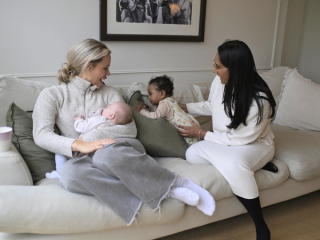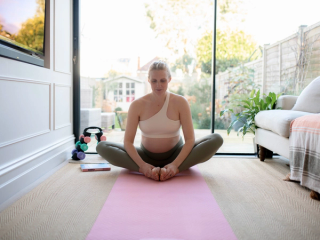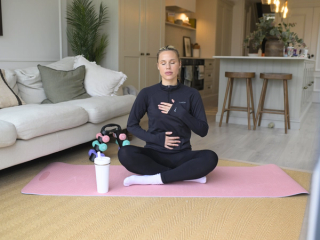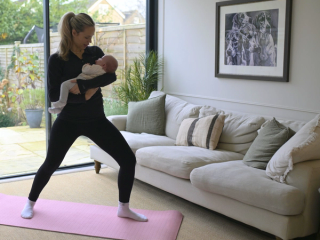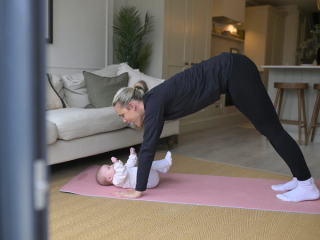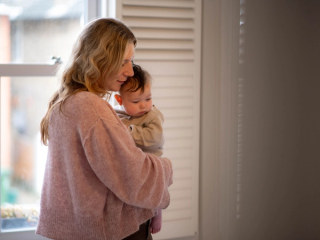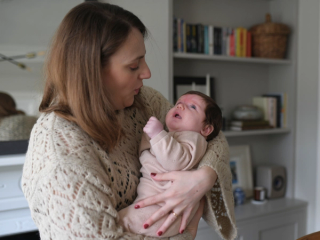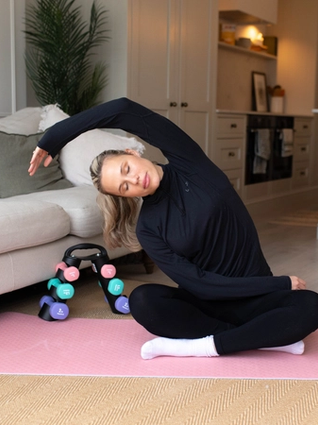
- Home
- Advice Hub
- Newborn
- Postnatal Care
- Postnatal Exercise
Postnatal Exercise
Explore effective postnatal exercise tips to help new moms regain strength and energy. Learn simple routines and the benefits of staying active after childbirth.
Reviewed by Christine Lane, Midwife and Consultant, on the 24.09.2025
Whether you're a regular at the gym, a seasoned runner, or completely new to exercise, getting back into movement after pregnancy can take time. Your body has been through a lot during pregnancy and birth, and even with a positive birth experience, recovery is still important. Try to be gentle with yourself and trust that your body will guide you – give it the time and care it needs to heal and adjust.
Many women can find the return to exercise frustrating to start with, especially if they deemed themselves to be fit and strong all the way up until the birth. It is vital that we get the beginning part of this rehab right in order to create a strong base on which to build. I have worked with many women who decided to go out on a 10k run just weeks after giving birth – with no prior rehab – and then they came to me for help because they discovered that their bodies were not ready for that kind of exercise yet.
When can I return to exercise safely?
This very much depends at what you are looking to return to and the extent of your injuries. You may have had your GP “sign you off” at your 6-8 week postnatal check. This is to sign you off as medically fit for general life, it is not a return to exercise check. If at all possible, I would advise booking in to see a pelvic health physio to have a thorough check if you’re unsure.
Time frames are generally unhelpful because of how much it can vary from one person to another. A more useful marker is hitting recovery goals. For example, when you are free from all symptoms you can start increasing your walking pace and distance, or beginning gentle bodyweight exercises or begin incorporating yoga or post natal pilates into your weeks. How ready you are will be determined by many things, including the type of birth you have had, whether you have had any stitches or whether you are experiencing symptoms of prolapse.
The earliest we would look to return to weight training is 8 weeks and jogging is 3 months, these are due to the body’s set healing times that we cannot change. For the majority it is much longer because those markers are assuming you have had plenty of sleep, eaten well and had no setbacks (doesn’t really match with the average newborn experience!).
How can I return to exercise safely?
Whether you are planning to start exercising at 6 weeks or 6 months, you have to lay down the foundations first. Here are the four postnatal rehab steps and a good guide to postnatal exercise
Step 1 - Awareness
We start with breathing exercises and how you coordinate this with your pelvic floor and deep abdominal muscles. It’s important to be able to feel what your body is doing. You can tie your shoelace without looking at your hands, right?! You have the exact same brain-to-muscle pathway to these important muscles, it just isn’t well trodden. With enough practice we can make a clear pathway that gives you great feedback. This creates a strong foundation to build on.
Step 2 - Control
Now we start putting this great awareness into practice with whole body movements. It’s all very well being able to control your pelvic floor and deep abdominals on their own, but can we coordinate it with movement. This is a great time to start gentle stretches, postnatal Pilates or yoga, as this will help you regain control and to develop flexibility throughout your body.
Step 3 - Strength
This step is where we start to challenge our body and so would be started once all acute healing has taken place, usually 8 – 12 weeks at the earliest. We need to start to build resistance into your exercise to strengthen your whole body. This step is skipped the most and therefore where issues can begin for some.
If you are looking at HIIT, running or sport you must rebuild the strength that would have been lost whilst you were growing a baby. You can’t start where you left off because you did a few weeks of postnatal Pilates. Did you know for example that to significantly reduce risk of injury when jogging you need to be able to perform 20 single leg bridges in a row? That’s hard!
Even if you have no interest in higher intensity exercise, we want to start training your body for motherhood. After all your little bundle will get increasingly heavy and you are lifting heavy weights every day! Think of how heavy that buggy is when you lift it into the car boot – the average buggy weight is 20 kg. Symptoms such as low back pain are our body’s way of communicating that it can’t cope with the demands being placed on it. We need to train our body for what we are asking it to do day to day.
Step 4 - Function
All the building blocks of awareness, control and strength can now be put into practice so you can live a full life – hooray! This might be being able to participate in Mum’s race at sports day, jump on the trampoline with your toddler, or getting back to a full exercise regime. It is so important not to get carried away at this stage and still gradually introduce these new activities. You can’t go from no impact to sprinting, or light weights to Olympic weight lifting. The Couch to 5k programme is free and a great gradual introduction to impact. This is really where you will reap the rewards of your patience and hard work.
At the start of your postnatal journey, exercise can feel daunting. However, whilst your postnatal body is different, it is no less powerful and capable with the right support. Plus, there is so much help out there with pelvic health physiotherapists and postnatal specialist fitness trainers, so reach out if you need some guidance. Most important, listen to your body and take it slow.
It is widely recommended that women wait until around 6 weeks before starting exercise...
and I have to say that I agree with this; however, it doesn’t mean that from week 1 – 6 you should sit on the sofa and do nothing. Yes, you need to prioritise rest, but from as early as you feel comfortable in doing so, you can start to reintroduce your pelvic floor exercises and core breathing as part of your postpartum exercises.. It is sensible to begin reconnecting your brain to those all-important core and pelvic floor muscles again. These can be done in a seated or lying position and don’t impact rest.
When you feel ready, short walks with or without the buggy are a great way to get the body moving again and over time you can steadily build up the distance and time spent walking. An added bonus is that babies often love to sleep on-the-go, so you can keep your baby snoozing while you get moving. Gentle stretching and rest during the first 6 weeks will help your body naturally rehabilitate, allowing your organs to return to their original positions and scars from episiotomies or C-sections to heal. When it comes to postnatal exercises, there are a huge number of things that you can do so it is important to find something that you both enjoy and feel comfortable doing so you are more likely to be consistent with it.
Pilates
When you get the all clear from your doctor or physio, I would recommend starting with Pilates-based exercise. You can start off by going to a post-natal Pilates class, working with a PT, doing a class at home, or just incorporating some bodyweight exercises focusing on the breath and alignment. Pilates is wonderful for easing the body back into exercise in a gentle way. It is kind to your joints and has a strong focus on moving in the right way rather than just moving, and that’s exactly what we need after our bodies have been through pregnancy.
Weights
If you are someone who likes lifting weights then you can start with light weights once you feel that you are mastering the bodyweight movements and your body feels happy with them, during and afterwards. You need to listen to your body to determine how fast and how much to increase the weights, as there is certainly no one size fits all here. Don’t make the mistake of lifting weights as heavy as you did pre pregnancy to begin with; your body will need to build up to that again.
Running
I know there will be some keen runners reading this, so I wanted to make sure I touched on it. However tempting it may be, please don’t lace up those running trainers straight away. In order to get back to running it’s important that you prepare your body for it because what it has been through will have had a big impact on it. The time frame will depend on how much you ran before or even during pregnancy, but also on how your birth went, what kind of birth you had, how your body is recovering etc.
Physios have released updated guidance over the last few years that suggest that the best time to get back to running after birth is 6 months. Don’t panic. I know this may seem like a long time to many of you, but this is merely a guide and everyone is different. But what it is suggesting is that you need to put aside some serious time to rehabilitate your body and get it ready for running before you set off for your first run.
Your body is carrying those pregnancy hormones for a while after you give birth, and even longer if you choose to breastfeed, so you still need to be mindful of this when you introduce impact work back into your workouts. Building strength in your muscles to support joints such as hips, knees, ankles is vital for returning to running. There are plenty of exercises that are great for building strength – for example, landing on one leg, rebounding from one to the other – so make sure to start adding them into your workouts before you hit the pavement.
Whatever it is that you’d like to get back to, or start for the first time, after birth the main thing to remember is that it doesn’t happen overnight. Even if you were an advanced athlete before pregnancy, it will still take some time to build up your strength and fitness to get you back there, but you absolutely will, so be patient with yourself and don’t jump in at the deep end.
